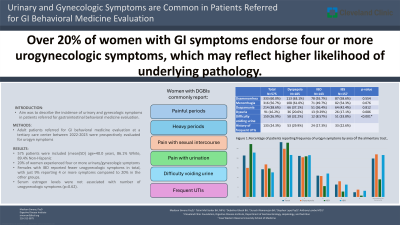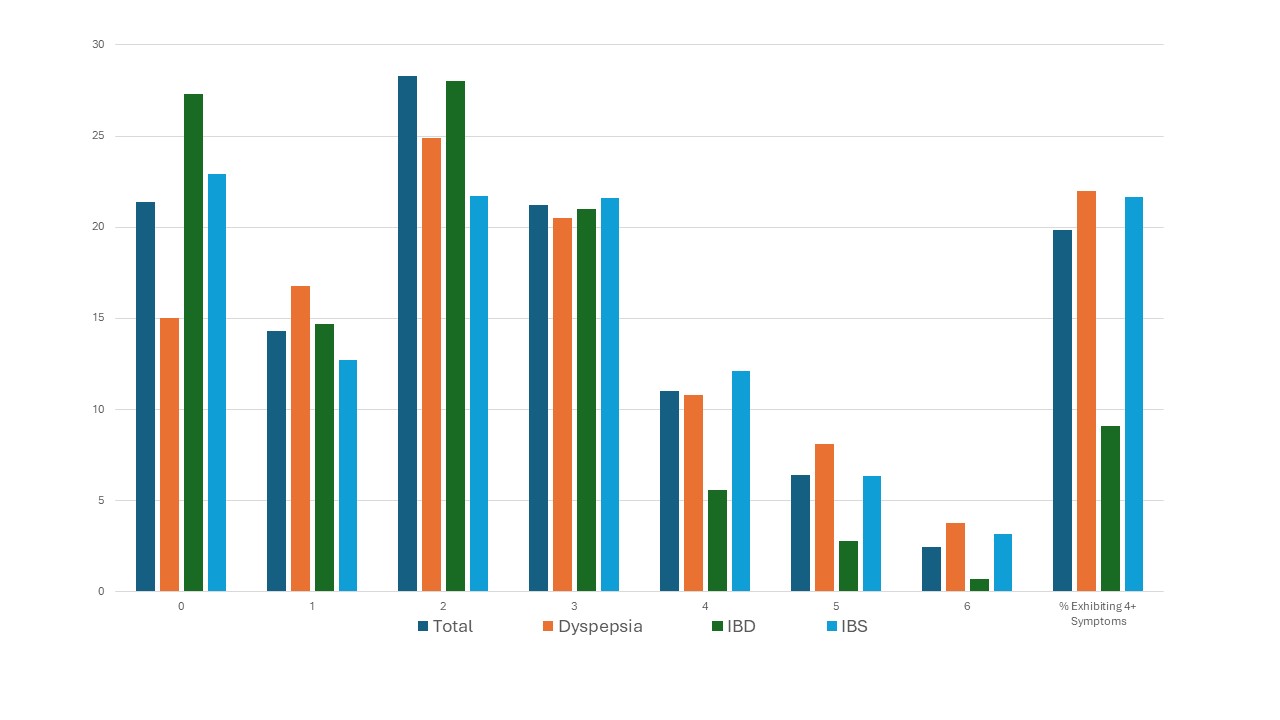Sunday Poster Session
Category: Functional Bowel Disease
P0621 - Urinary and Gynecologic Symptoms are Common in Patients Referred for GI Behavioral Medicine Evaluation
Sunday, October 27, 2024
3:30 PM - 7:00 PM ET
Location: Exhibit Hall E

Has Audio

Madison Simons, PhD
Cleveland Clinic
Cleveland, OH
Presenting Author(s)
Madison Simons, PhD1, Tatini Mal-Sarkar, MPH2, Debolina Ghosh, BA2, Suruchi Ramanujan, MD3, Stephen Lupe, 1, Anthony J. Lembo, MD4
1Cleveland Clinic, Cleveland, OH; 2Case Western Reserve University School of Medicine, Cleveland, OH; 3University of California San Diego, Cleveland, OH; 4Digestive Disease Institute, Cleveland Clinic, Cleveland, OH
Introduction: Many patients with chronic gastrointestinal (GI) symptoms describe concurrent urinary or gynecologic symptoms, which may increase visceral sensitivity in the abdomino-pelvic region and amplify distress around digestive symptoms. The aim of this study was to describe the incidence of urinary and gynecologic symptoms in patients referred for gastrointestinal behavioral medicine evaluation.
Methods: Adult patients referred for GI behavioral medicine evaluation at a tertiary care center between 2022-2023 were prospectively evaluated for symptoms associated with urinary and gynecologic dysfunction, including dysmenorrhea, menorrhagia, dyspareunia, difficulty emptying the bladder, and history of frequent urinary tract infections. Descriptive statistics were conducted to assess prevalence of these symptoms within this population. In a subset of patients, Spearman’s rank correlation coefficient was used to assess the relationship between urogynecologic symptoms and serum estrogen level. Patients were broken down into diagnostic group: esophagus, dyspepsia, inflammatory bowel disease, and irritable bowel syndrome (IBS).
Results: 575 patients were included in the cohort with a mean(SD) age=40.0 years (SD?), 86.1% White, 89.4% Non-Hispanic. Dysmenorrhea (60.0%) and menorrhagia (56.7%) were commonly reported among women with digestive symptoms. Urinary symptoms were less frequent, with 16.2% reporting pain with urination, 26.9% reporting difficulty voiding urine, and 24.3% reporting a history of frequent UTIs. 20% of women experienced four or more urinary/gynecologic symptoms. There were no significant differences in the type of urogynecologic symptoms reported based on diagnostic group, except women with IBD were significantly less likely to report difficulty voiding urine. Females with IBD reported fewer urogynecologic symptoms in total, with just 9% reporting 4 or more symptoms compared to 20% in the other groups. Serum estrogen levels were not associated with number of urogynecologic symptoms (p=0.62).
Discussion: Urinary and gynecologic symptoms are common among patients with digestive conditions and these may be more common in disorders of gut brain interaction than in IBD. We presume the presence of these comorbid symptoms are likely to impact symptom severity and could affect treatment response. Future study will be necessary to understand the mechanisms behind these shared conditions as well as develop effective treatments that address their overlap.

Note: The table for this abstract can be viewed in the ePoster Gallery section of the ACG 2024 ePoster Site or in The American Journal of Gastroenterology's abstract supplement issue, both of which will be available starting October 27, 2024.
Disclosures:
Madison Simons, PhD1, Tatini Mal-Sarkar, MPH2, Debolina Ghosh, BA2, Suruchi Ramanujan, MD3, Stephen Lupe, 1, Anthony J. Lembo, MD4. P0621 - Urinary and Gynecologic Symptoms are Common in Patients Referred for GI Behavioral Medicine Evaluation, ACG 2024 Annual Scientific Meeting Abstracts. Philadelphia, PA: American College of Gastroenterology.
1Cleveland Clinic, Cleveland, OH; 2Case Western Reserve University School of Medicine, Cleveland, OH; 3University of California San Diego, Cleveland, OH; 4Digestive Disease Institute, Cleveland Clinic, Cleveland, OH
Introduction: Many patients with chronic gastrointestinal (GI) symptoms describe concurrent urinary or gynecologic symptoms, which may increase visceral sensitivity in the abdomino-pelvic region and amplify distress around digestive symptoms. The aim of this study was to describe the incidence of urinary and gynecologic symptoms in patients referred for gastrointestinal behavioral medicine evaluation.
Methods: Adult patients referred for GI behavioral medicine evaluation at a tertiary care center between 2022-2023 were prospectively evaluated for symptoms associated with urinary and gynecologic dysfunction, including dysmenorrhea, menorrhagia, dyspareunia, difficulty emptying the bladder, and history of frequent urinary tract infections. Descriptive statistics were conducted to assess prevalence of these symptoms within this population. In a subset of patients, Spearman’s rank correlation coefficient was used to assess the relationship between urogynecologic symptoms and serum estrogen level. Patients were broken down into diagnostic group: esophagus, dyspepsia, inflammatory bowel disease, and irritable bowel syndrome (IBS).
Results: 575 patients were included in the cohort with a mean(SD) age=40.0 years (SD?), 86.1% White, 89.4% Non-Hispanic. Dysmenorrhea (60.0%) and menorrhagia (56.7%) were commonly reported among women with digestive symptoms. Urinary symptoms were less frequent, with 16.2% reporting pain with urination, 26.9% reporting difficulty voiding urine, and 24.3% reporting a history of frequent UTIs. 20% of women experienced four or more urinary/gynecologic symptoms. There were no significant differences in the type of urogynecologic symptoms reported based on diagnostic group, except women with IBD were significantly less likely to report difficulty voiding urine. Females with IBD reported fewer urogynecologic symptoms in total, with just 9% reporting 4 or more symptoms compared to 20% in the other groups. Serum estrogen levels were not associated with number of urogynecologic symptoms (p=0.62).
Discussion: Urinary and gynecologic symptoms are common among patients with digestive conditions and these may be more common in disorders of gut brain interaction than in IBD. We presume the presence of these comorbid symptoms are likely to impact symptom severity and could affect treatment response. Future study will be necessary to understand the mechanisms behind these shared conditions as well as develop effective treatments that address their overlap.

Figure: Figure 1. Number of Urogyn Symptoms Reported by Disease Group
Note: The table for this abstract can be viewed in the ePoster Gallery section of the ACG 2024 ePoster Site or in The American Journal of Gastroenterology's abstract supplement issue, both of which will be available starting October 27, 2024.
Disclosures:
Madison Simons indicated no relevant financial relationships.
Tatini Mal-Sarkar indicated no relevant financial relationships.
Debolina Ghosh indicated no relevant financial relationships.
Suruchi Ramanujan indicated no relevant financial relationships.
Stephen Lupe: Ayble Health – Consultant.
Anthony Lembo: Allurion – Stock Options. Bristol Myers Squibb – Stock Options. Johnson & Johnson – Stock Options. Vibrant Advisory Board – Advisory Committee/Board Member.
Madison Simons, PhD1, Tatini Mal-Sarkar, MPH2, Debolina Ghosh, BA2, Suruchi Ramanujan, MD3, Stephen Lupe, 1, Anthony J. Lembo, MD4. P0621 - Urinary and Gynecologic Symptoms are Common in Patients Referred for GI Behavioral Medicine Evaluation, ACG 2024 Annual Scientific Meeting Abstracts. Philadelphia, PA: American College of Gastroenterology.
